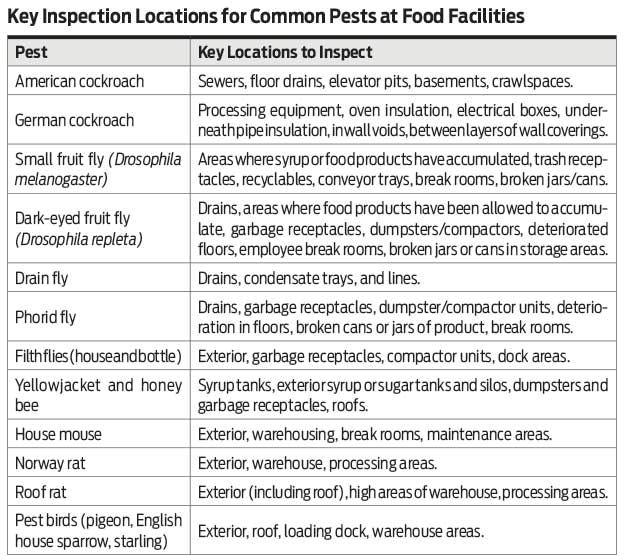By Pat Hottel
Clients will, and must, play an important role in the success of the pest management program at their food plant. Their assistance is necessary in pest prevention, and it often helps in solving pest problems that occur. Pest prevention starts with proper facility design, and whenever possible, the PMP should be consulted on new designs and renovations. Key pest-prevention considerations in building design include:
- Location. Facilities in areas that are heavily wooded, or border farm fields or bodies of water, will be subjected to pest pressures.
- Cleanability. Equipment and structural components should be selected based on their ability to be cleaned. Equipment should be placed in a manner that will facilitate cleaning, so there are no areas between equipment and walls or floors that cannot be easily or effectively cleaned.
- Durability. Structural surfaces and equipment should be able to withstand the processing that occurs in the area. For liquid-processing plants, this could include heavy use of sanitizers, heat and water (often applied with high-pressure cleaning equipment). Deterioration, such as loss of tile grouting and breakdown of epoxy floor coverings, can be a major issue in wet-processing areas.
- Lighting. Especially around the exterior of the building, lights can serve as attractants to insects. Use sodium-vapor versus mercury-vapor lighting. Install lights off or away from the building where permissible, and direct lights toward the structure as needed. Use daylight or motion sensors when feasible to reduce the time that lighting remains on.
- Other considerations. The use of air curtains and quick roll-up doors can add additional pest barriers. Water-management systems and drains should be designed so they can properly accommodate wastewater generated, and ensure that floors are constructed so water is properly funneled toward floor drains.
Ongoing actions for pest prevention need to be addressed once the site is constructed. Many of these duties are outlined in FDA’s GMPs for food plants. Assistance that clients should provide to pest managers include:

- Making sure that all doors, windows, vents and other entry points to the plant are maintained in a pest-proof condition.
- Keeping unscreened doors and windows closed when not in use.
- Developing and adhering to cleaning schedules for all areas, including areas where product residues may accumulate.
- Maintaining sanitation aisles around product storage areas to facilitate inspection and monitoring/control equipment placement.
- Reducing clutter and unnecessary equipment storage.
- Storing equipment in a clean and sealed condition.
- Sealing structural components that may serve as harborage sites for pests. Sealants should be monitored regularly for integrity.
- Using fans or squeegees to avoid moisture accumulation and to dry floors.
- Following first in/first out systems (FIFO) of stock rotation to avoid keeping any materials, products or ingredients past their intended shelf life.
- Reporting all pest sightings.
- Storing personal items like lunches only in designated storage areas.
- Eating only in designated areas.
- Inspecting all incoming goods for signs of pests. Have a detailed procedure in place for the inspection of incoming and outgoing shipments, and action to take if a pest is found.
- Replacing any pest management equipment in its correct place (if moved during cleaning or other activities).
- Maintaining vegetation-free barriers around the immediate perimeter of the building exterior to avoid providing harborage or attractants for pests to these areas.
Pat Hottel is technical director at McCloud Services.
This Tech Talk article was originally published in the November 2018 edition of PCT magazine.

